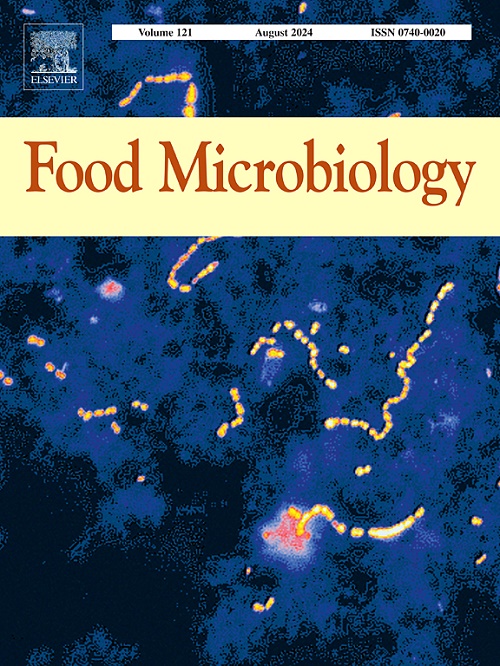Antibiofilm efficacies and mechanism of perillaldehyde against Shewanella putrefaciens
IF 4.5
1区 农林科学
Q1 BIOTECHNOLOGY & APPLIED MICROBIOLOGY
引用次数: 0
Abstract
Shewanella putrefaciens is Gram-negative bacterium and important spoilage organism in aquatic products, negatively impacting the organoleptic properties of aquatic products. S. putrefaciens could form biofilm, which increases persistence and contamination in food system. Efficient antibiofilm strategies are urgently needed to reduce its presence in food environment. This study aimed to explore the impact of perillaldehyde on S. putrefaciens biofilm and the underlying mechanisms using transcriptomic analysis. Perillaldehyde remarkably reduced extracellular polymeric substance contents, inhibited metabolic activity of biofilm cells, disrupted bacterial motility, loose biofilm structure and decreased biofilm formation in food juice and on various surfaces (stainless steel, silicone, glass, razon clam and shrimp). Transcriptome analysis revealed that 553 differentially expressed genes were identified, among which 254 were down-regulated and 299 were up-regulated. The differentially expressed genes included ATP-binding cassette transporters, ribosome, two-component systems, resistance/nodulation/division efflux systems, quorum sensing, amino acid metabolism, biosynthesis and degradation pathways. The findings demonstrate antibiofilm properties of perillaldehyde against S. putrefaciens and indicate that perillaldehyde could be developed as an antibiofilm agent to mitigate existence and contamination of S. putrefaciens and to reduce associated food loss caused by this spoilage bacteria.
紫苏醛抗腐烂希瓦氏菌的抗菌效果及作用机制
腐坏希瓦氏菌是革兰氏阴性菌,是水产品中重要的腐败菌,对水产品的感官特性产生负面影响。腐坏链球菌可以形成生物膜,增加食物系统的持久性和污染。迫切需要有效的抗生素膜策略来减少其在食品环境中的存在。本研究旨在通过转录组学分析探讨紫苏醛对腐臭链球菌生物膜的影响及其机制。紫苏醛显著降低了食品汁和各种表面(不锈钢、硅胶、玻璃、蛤和虾)中细胞外聚合物的含量,抑制了生物膜细胞的代谢活性,破坏了细菌的运动,使生物膜结构松散,减少了生物膜的形成。转录组分析显示,共鉴定出553个差异表达基因,其中下调基因254个,上调基因299个。差异表达基因包括atp结合盒转运体、核糖体、双组分系统、抗性/结瘤/分裂外排系统、群体感应、氨基酸代谢、生物合成和降解途径。研究结果证实了紫苏醛对腐臭葡萄球菌的抗菌膜特性,表明紫苏醛可以作为一种抗菌膜剂开发,以减轻腐臭葡萄球菌的存在和污染,并减少由这种腐败细菌引起的食物损失。
本文章由计算机程序翻译,如有差异,请以英文原文为准。
求助全文
约1分钟内获得全文
求助全文
来源期刊

Food microbiology
工程技术-生物工程与应用微生物
CiteScore
11.30
自引率
3.80%
发文量
179
审稿时长
44 days
期刊介绍:
Food Microbiology publishes original research articles, short communications, review papers, letters, news items and book reviews dealing with all aspects of the microbiology of foods. The editors aim to publish manuscripts of the highest quality which are both relevant and applicable to the broad field covered by the journal. Studies must be novel, have a clear connection to food microbiology, and be of general interest to the international community of food microbiologists. The editors make every effort to ensure rapid and fair reviews, resulting in timely publication of accepted manuscripts.
 求助内容:
求助内容: 应助结果提醒方式:
应助结果提醒方式:


